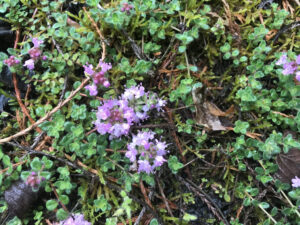- Like
- Digg
- Del
- Tumblr
- VKontakte
- Buffer
- Love This
- Odnoklassniki
- Meneame
- Blogger
- Amazon
- Yahoo Mail
- Gmail
- AOL
- Newsvine
- HackerNews
- Evernote
- MySpace
- Mail.ru
- Viadeo
- Line
- Comments
- Yummly
- SMS
- Viber
- Telegram
- Subscribe
- Skype
- Facebook Messenger
- Kakao
- LiveJournal
- Yammer
- Edgar
- Fintel
- Mix
- Instapaper
- Copy Link
A version of this column first ran in the Roane County (WV) Reporter and Times Record. Support local journalism! Subscribe to your local newspaper.
 In this blog I’m going to suggest that you consider growing a few flowers or herbs in your vegetable garden, if you have room. It’s not only because you can enjoy a vase of colorful flowers, or herbs to put in your cooking; these additions can actually help your vegetables. How?
In this blog I’m going to suggest that you consider growing a few flowers or herbs in your vegetable garden, if you have room. It’s not only because you can enjoy a vase of colorful flowers, or herbs to put in your cooking; these additions can actually help your vegetables. How?
If you choose the right ones—and there is a long list of good choices—flowers and herbs can serve your garden in two ways, both involving insects. First, many attract pollinators, not only honeybees but many native bees, butterflies and others. These insects are then around to pollinate your squash, peppers and strawberries. Many flower catalogs have symbols showing which plants attract pollinators.
Secondly, many of these plants attract predator bugs which eat the ones that cause you problems. Everyone knows ladybugs eat aphids, but there are quite a few other bugs that act as the cops in your garden. Praying mantises ought to be called preying mantises, for all the bugs they eat—they relish those nasty brown marmorated stinkbugs, for one.
Many of the flowers and herbs in my garden I didn’t actually plant—orange butterfly weed sprang up from where the initial tilling missed it, and thrives in the good soil there, creating a giant ball with hundreds of glowing orange flowers and a dozen butterflies. Yarrow volunteered a couple of years ago with white flowers I pick for bouquets; they also feed certain predators. Chamomile and feverfew drifted over from my flower-and-herb garden not far away. I actually did plant marigolds, cosmos, and borage but these then self-seeded for future years.
Thyme, sage, fennel and rosemary are herbs I planted for use in cooking, but they may also attract predator bugs. Rosemary is not hardy here, however; it usually needs to be planted again every spring. The fennel also can feed caterpillars. However, it puts out something harmful to neighboring plants, so think about where to put it. Some of these plants can help your vegetable garden without actually being in it, as long as they’re nearby; so can wildflowers if there is an un-mowed area near your garden.
This is part of how organic gardeners and farmers grow good crops without poisons; they grow a lot of different crops and rotate them each year. A big field with nothing but one crop is an invitation to whatever bothers that crop. Having many wild plants flowering creates a balance, a healthy ecosystem in which predators step in when some creature gets numerous and bothers your plants too much. This is also often the principle behind companion planting, but that’s controversial, as to whether it really works. Often it’s claimed that marigolds or herbs will repel the pests of cabbages or some other plant; I think what they really do is mask the scent of the cabbage, which is what’s drawing those pests (in that case, especially a white butterfly with a black dot on each wing, which lays eggs that become worms in broccoli, cabbage and relatives). Unfortunately I don’t think one marigold will accomplish this in a bed of a dozen broccoli. It would probably work if you had a couple of cabbages in a bed of marigolds…
I want to mention a couple of strong-smelling herbs that require caution. I like having mint—but mints have the social attitudes of Attila the Hun. Even when I had one in a bottomless bucket set in the ground, it pushed roots through the hole in the bottom, which snaked under the aisles in my flowerbed and then mint came up in every surrounding bed. Now I have mint in buckets that sit on gravel.
I also tried garlic chives, which make pretty white flowers—and then seed all over the place. I finally eradicated it from my vegetable garden but can’t get the last of it out of my flowerbed. I advise against planting this one. Cosmos makes a nice late summer flower in a variety of colors, and will self-seed.
Use the comment section for questions, objections and suggestions.
